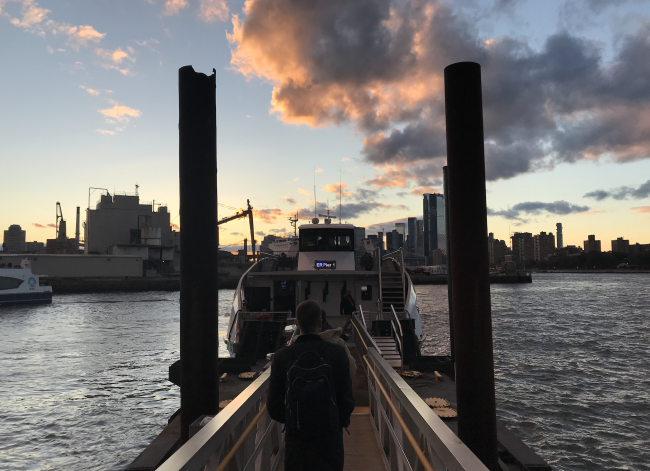6 tips for surviving a long commute like a real New Yorker

No matter how much of a New Yorker you are, using transit apps are essential when facing a long commute.
As a long time Astoria resident, I often joked that the Rite Aid just a few blocks from my apartment was as far as I would ever move in Queens. But when my boyfriend and I decided to live together, I quickly learned that for the price we were willing to pay, and our mutual desire to stay in Queens, I would have to venture farther into Queens—and sacrifice a short commute into Manhattan.
After months of apartment hunting, we settled on a large studio in Rego Park, a neighborhood I had never heard of. I was excited to know that I would be living off the M and R line, the same line that I took to Astoria. But the seven extra stops quickly turned into routine late arrivals to my job, and the long commutes were filled with boredom and annoyance, and the steady decline of my social life.
That was then. It’s been just over two years since my once 15-to-20 minute commute turned into a solid 45 minutes and just like any New Yorker, I found my own way to survive. With rents rising and new development coming to the outer boroughs, you may be contemplating a similar move.
Check out my six tips to surviving a long NYC commute, because no matter how much you love your neighborhood, you too may end up doubling your commute someday.
1. Use transit apps, no matter how much of a New Yorker you are
I know it sounds obvious, but when your commute doubles, it’s essential to know if there are any delays or planned construction along your line. It's especially key on weekends when ongoing “improvements” often cause trains to go express from certain stops, skipping yours.
When that would happen to me in Astoria, I would simply walk about 10 minutes down Broadway to the N and W line or take the R two stations back and transfer at Jackson Heights, but in Rego Park, I live directly between two stations on the same line, so I don’t have alternate train options. Having to ride to the last stop in Queens then back towards Manhattan takes a bit longer.
It’s also essential to know how long until the next train arrives when you’re commuting from farther away. If you have to wait for a solid 10 minutes, or more, for the next train and have not even started your long commute, you’ll most likely be late to your destination. I quickly learned the exact time the train left each day that would get me to work on time, and I now make sure I make it to the bottom of the steps before that train arrives every morning.
2. Find a podcast to binge-listen during your commute
Listening to music was my go-to while I scrolled aimlessly through social media during my short commute—but once my commute doubled, music wasn’t doing the trick. That’s when I decided to give podcasts a shot. I had not listened to a podcast, other than Serial, which is probably the one podcast almost everyone has listened to, before this. As a self-professed true crime junkie, I discovered My Favorite Murder, a podcast that had been around for a couple of years—providing me with a catalog of episodes to get me through my daily commute.
Podcasts entertain and inform you the same way audiobooks or TV shows do, so once you find one that interests you, an episode can distract you so that your commute seems to fly by. If you like true crime, My Favorite Murder, Crime Junkie, and The First Degree are some of my favorites. News junkie? The New York Times’s podcast The Daily is a quick listen to get you in the know for your water-cooler conversations. If real estate is your thing, there is, of course, The Brick Underground podcast. For bookworms reading a good book can do the trick.
Sidenote, if you use wireless headphones like I do, always make sure they’re charged for the ride. There’s nothing worse than facing a long morning commute without headphones. I carry an extra pair of wired headphones with me, just in case.
3. Save time, and money, by bringing coffee on your ride
After being late several times at my job during the first couple of months at my new place, I quickly had to figure out how to get to work faster so I didn't have to start waking up earlier. I realized that walking past the station to get my coffee at Starbucks, then waiting in line to order, then again to receive my order, was not going to cut it anymore. At first, I started using the Starbucks app to place a mobile order so that I could grab my coffee and rush to the train, but even then my order was not always ready or the train would arrive a minute early and I would miss it.
After trial and error, I finally decided that I had to cut out my coffee stop altogether. But as someone who could not walk into work without consuming coffee, I got a Keurig machine and started making coffee at home. This not only gave me a few extra minutes at home, but it also allowed me to go directly to the station, with coffee in hand. The 45-minute commute was long enough for me to finish my coffee— turning my ride into an extended coffee-break and fueling me up to function at work.
Even if you prefer to grab your caffeinated beverage at Starbucks, or your neighborhood cafe, build time into your commute to do so before getting on the train so you aren’t joining a long queue at the cafe near your job, after an already long commute.
4. Find a friend to commute with
This may sound corny, and is definitely not feasible for everyone, but if you have a roommate, or a friend that lives nearby, who leaves for work around the same time as you, try to coordinate your travels! My boyfriend and I were able to commute together for a few months, before our schedules changed, and having a conversation with someone distracts you so that you’re not paying attention to each station stop. Next thing you know, you’re only a stop away from your destination!
For me, my social life changed drastically when I knew that I had to face an almost hour commute home, and deal with express trains going local, and long wait times commuting home late on a weekend, while drunk! Since Uber rides were no longer a cheap option, having friends that live nearby to commute home with is often what gets me to go to that party or event. Lucky for me, I live with my boyfriend, and my party animal best friend only lives a stop away. So, anytime we’re heading for a night out, we often coordinate when we leave so we end up on the same train and can trek to the party, and back home, together. What’s better than continuing the party by taking it on a delayed train back home with your drunk friend?
5. Learn where to stand on the platform
Most New Yorkers who commute regularly know which train car to ride in, and which door to exit, so that they are closest to the exit they need to get to work or home. For me, at my last job I needed the very last car to get to work. Knowing this allowed me to always get a seat since it was the last car, and more importantly—saved me time because I was able to run right up the stairs and out of the station, rather than walking from one end of the station to the other in order to exit.
Getting home, I always ride in the second car, and use the second door to exit, so that I get out at the exit I need to walk as little as possible back to my apartment. Be warned, some trains are shorter than others so you may have to exit from a different door if you aren’t using the same line everyday. But knowing your exit strategy prevents you from walking more, therefore making your long commute as short as possible.
If you want to take it to the next step, I recommend figuring out what exit you need to use to get to some of your common neighborhood stops. Other aspects you can learn in order to fully take advantage of your station, and cut down on time during your already long commute, is finding out which entrance is closest to MetroCard vending machines.
6. Use faster, more comfortable express options when you can
One of my close friends commutes from Bay Ridge to her job on Fifth Avenue in Midtown East, which is a solid hour ride. When she has to get to work earlier than usual, or wants to have a more enjoyable commute back home, she opts for the express bus provided by the MTA, that costs $6.75—and is not covered by an unlimited Metrocard.
For her, it’s not always worth the extra cost, but it does cut her hour commute by 20 minutes, so although it’s still a lengthy commute, she gets a more comfortable ride. The buses tend to be cleaner, the seats are comfortable, and there are outlets on the bus. Be warned, she does suggest staying away from the service after 10 a.m., because there is more traffic and the HOV lanes close, so the $6.75 ride can then end up taking longer.
You Might Also Like



























